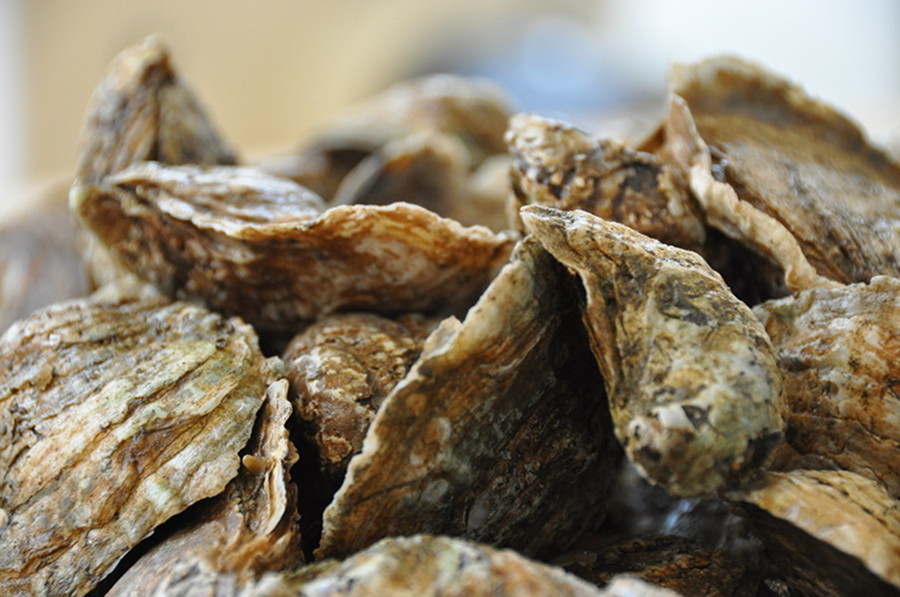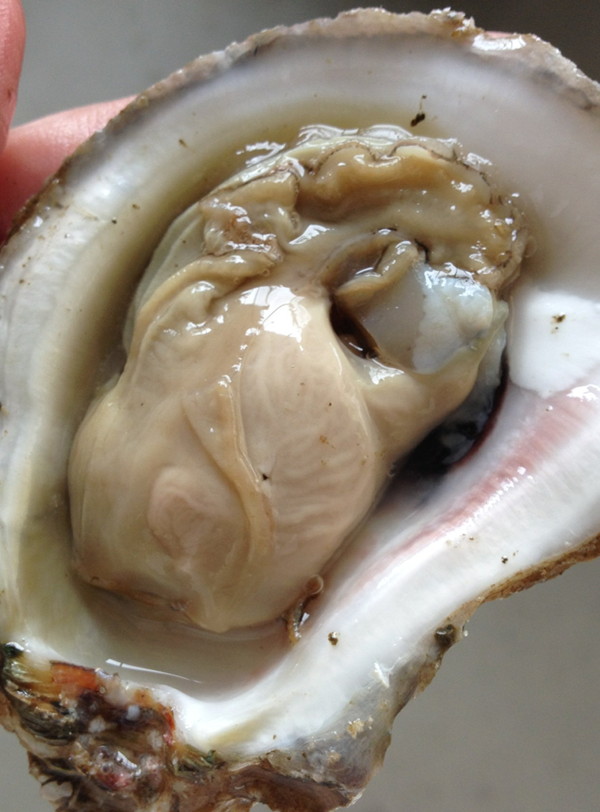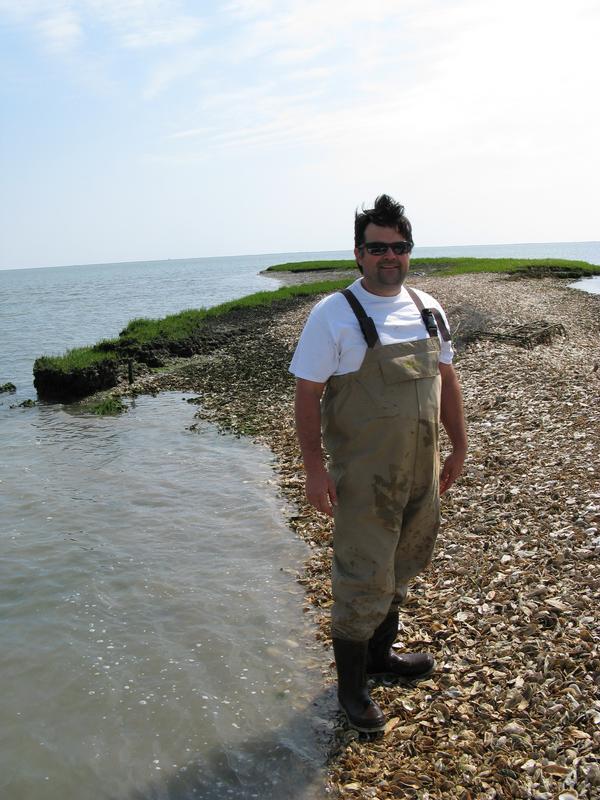The Oyster
There is a lot to learn about oysters. Below, we touch on some highlights about different oysters around the world, as well as their ecological and nutritional impacts.
Types of Oysters
Many people think that all oysters make pearls, but that is not the case. Most molluscs that have shells can create pearls, but the highly valuable pearls we see as jewelry come from a specific variety of pearl oysters, the largest of which is Pinctada maxima. We sometimes find pearls in Eastern oysters, but they are usually quite small and misshapen. |
Anatomy and Biology
Oysters are protrandric, meaning that they begin life as males, however, as they grow older and larger, can switch sexes and becomes female. Eastern oysters are broadcast spawners, releasing eggs and sperm into the water column, where the eggs are fertilized. Embryos develop into the free-swimming larval stage. Some female oysters can produce as many as 100 million eggs in a single spawning event! Oyster larvae spend roughly two and a half weeks swimming, eating and growing before they attach to a hard substrate and go through metamorphosis. From this point onward, oysters are sessile, meaning they are fixed in one place. For more information on the life cycle of oysters, see Raising Oysters. |
Habitat and Ecosystem Services
Oysters are filter feeders and play a valuable role removing nitrogen, phosphorus, plankton, detritus, and dissolved organic material from the water. Their filtering capacity is tremendous, as high as 50 gallons per day, so oysters can be very important in maintaining or improving water quality. Oysters are reef-builders. Planktonic larvae are attracted to the calcium in the shells of adult oysters, so often gravitate towards locations where oysters already exist, forming large and intricate reefs. These reefs provide valuable habitat to other marine life such as fish, crabs, and benthic invertebrates, just to name a few. |
Oysters as Food
Oysters have many nutritional benefits, being rich in vitamins and minerals such as iron, zinc, magnesium, phosphorus, copper, selenium, and vitamin B12. Farmed oysters, as a protein source, are shown to have less environmental impact than the beef or chicken industry. It has been argued that if Americans swapped 10% of their meat consumption for oysters, greenhouse gas savings would be the equivalent of keeping nearly 11 million cars off of the road. Many great oyster recipes, festivals, tours, and experiences can be found here in Virginia and around the world. Virginia is for Oyster Lovers, Virginia Oyster Trail, Virginia Seafood Council, and Virginia's River Realm are good places to start in our local area! |


 There are many types of oysters, however, “true” oysters are only those in the family Ostreidae. The genus Crassostrea is part of the family Ostreidae, and includes the Eastern oyster, Crassostrea virginica, found in Chesapeake Bay. Other well-known oyster varieties around the world include the Pacific oyster, Crassostrea gigas, the Asian oyster, Crassostrea ariakensis, and the European Flat oyster, Ostrea edulis.
There are many types of oysters, however, “true” oysters are only those in the family Ostreidae. The genus Crassostrea is part of the family Ostreidae, and includes the Eastern oyster, Crassostrea virginica, found in Chesapeake Bay. Other well-known oyster varieties around the world include the Pacific oyster, Crassostrea gigas, the Asian oyster, Crassostrea ariakensis, and the European Flat oyster, Ostrea edulis. Oysters are bivalves, meaning that they have two hinged, opposing shells. Oysters have a large adductor muscle which they use to open and close the shells. Within the shells are the soft organs of the oyster, including the mantle, which secretes the shell and over which gas exchange occurs. They have four rows of gills, which are used for feeding in addition to getting oxygen from the water; phytoplankton and other particles are trapped on the mucus of the gills when the oyster is open and feeding, and from there, the food particles are transported to the mouth. Oysters have a three-chambered heart, which is found under the adductor muscle. The blood of oysters is colorless and is pumped by the heart throughout the body. They also have two kidneys. While lacking a brain, the nervous system of oysters includes a pair of nerve cords and three pairs of ganglia.
Oysters are bivalves, meaning that they have two hinged, opposing shells. Oysters have a large adductor muscle which they use to open and close the shells. Within the shells are the soft organs of the oyster, including the mantle, which secretes the shell and over which gas exchange occurs. They have four rows of gills, which are used for feeding in addition to getting oxygen from the water; phytoplankton and other particles are trapped on the mucus of the gills when the oyster is open and feeding, and from there, the food particles are transported to the mouth. Oysters have a three-chambered heart, which is found under the adductor muscle. The blood of oysters is colorless and is pumped by the heart throughout the body. They also have two kidneys. While lacking a brain, the nervous system of oysters includes a pair of nerve cords and three pairs of ganglia. The Eastern oyster can live in a wide range of marine environments, from almost fresh water to full-strength seawater. They can osmoregulate, meaning that they can adapt to changing salinity, an adaptation that allows them to withstand fluctuations in their environment. Oysters can withstand a wide range of water temperatures. In the winter, for example, they do not hibernate, but do slow their growth and feeding to survive in near-freezing water. They will feed more readily and grow when the water temperature is above 10°C (50°F).
The Eastern oyster can live in a wide range of marine environments, from almost fresh water to full-strength seawater. They can osmoregulate, meaning that they can adapt to changing salinity, an adaptation that allows them to withstand fluctuations in their environment. Oysters can withstand a wide range of water temperatures. In the winter, for example, they do not hibernate, but do slow their growth and feeding to survive in near-freezing water. They will feed more readily and grow when the water temperature is above 10°C (50°F). Not only are oysters important ecologically and aid in maintaining water quality, but you can eat them! Raw oysters, when harvested by a certified shellfish harvester and sold at retail establishments, are safe to eat all year. You can fry, roast, bake, broil, or grill oysters, if you prefer them to be cooked! Because oysters are filter feeders, their meat takes on flavor qualities of the water around them. Oysters that are grown in seawater with a high salt content taste very different from those grown in more brackish waters.
Not only are oysters important ecologically and aid in maintaining water quality, but you can eat them! Raw oysters, when harvested by a certified shellfish harvester and sold at retail establishments, are safe to eat all year. You can fry, roast, bake, broil, or grill oysters, if you prefer them to be cooked! Because oysters are filter feeders, their meat takes on flavor qualities of the water around them. Oysters that are grown in seawater with a high salt content taste very different from those grown in more brackish waters.